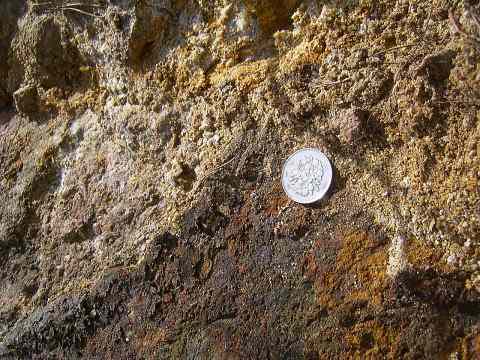Itaga Mine
Itaga, Kanuma city, Tochigi pref., Japan
Synonym
Mori Mine
Occurrence
W pneumatolytic deposit associated with the early Paleocene (63 Ma) Karasawa Granodiorite intruded in Kurohone-Kiryu Complex, a member of Jurassic accretionary complex of Tamba-Mino-Ashio Belt. The Karasawa granodiorite is S-type (Ilmenite-series). Ages of granodiorite were determined by K-Ar radiometric dating of muscovite and biotite.

Outcrop of andalusite-bearing quartz vein in the Karasawa Granodiorite. The pink part at the left of the scale coin is the andalusite-rich quartz vein associated with colorless fluorite, topaz, and muscovite. The wall rock at the top of this photograph is brown granodiorite altered by weathering.
Reported Minerals
- Copper
- Fluorite
- Corundum
- Goethite
- Molybdenite
- Lollingite
- Chalcopyrite
- Ferberite
- Andalusite
- Topaz
- Jarosite
- Scorodite
- Schorl
Mineral Assemblages
- Quartz - Andalusite - Muscovite - Corundum - Fluorite - Topaz
- Quartz - Lollingite - Ferberite
- Quartz - Molybdenite
- Quartz - Schorl
History
- around 1900: Explored for Au-Ag and Cu.
- 1939: Granodiorite-hosted W deposit was discovered.
- 1940-1945: W was open-pit mined during World War II.
- 1952: Hornfels-hosted W deposit was discovered, and mined.
- 1961: Closed. Produced 23.5 ton W concentrates.
Locality
- Takatori Mine (Ferberite)
- Ebisu Mine (Wolframite)
- Togane Mine (Wolframite)
- Komaki Mine (Wolframite)
- Itaga Mine (Andalusite)
- Otani Mine (Cassiterite, Scheelite)
- Taisho Mine (Cassiterite)
- Ichiyanagi Mine (Löllingite)
- Takane Mine (Bismuth)
- Karasawa Mine (Bismuth)
- Takemori (Dravite)